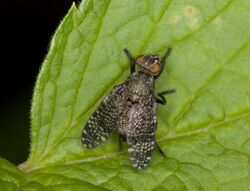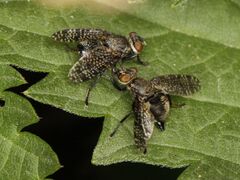Biology:Platystoma seminationis
| Platystoma seminationis | |
|---|---|

| |
| Scientific classification | |
| Domain: | Eukaryota |
| Kingdom: | Animalia |
| Phylum: | Arthropoda |
| Class: | Insecta |
| Order: | Diptera |
| Family: | Platystomatidae |
| Genus: | Platystoma |
| Species: | P. seminationis
|
| Binomial name | |
| Platystoma seminationis (Fabricius, 1775)
| |
| Synonyms | |
| |
Platystoma seminationis, the dancing "kiss fly", is a species of fly in the family Platystomatidae.[2]
Subspecies
Subspecies include: [2][3]
- Platystoma seminationis angustipenne Loew, 1854
- Platystoma seminationis bisetum Loew, 1868
- Platystoma seminationis frauenfeldi Nowicki, 1867
- Platystoma seminationis rufimanum Loew, 1873
- Platystoma seminationis seminationis (Fabricius, 1775)
Distribution
This species is present in most of Europe (Austria, Belgium, United Kingdom , Russia , Czech Republic, Denmark , Finland , Germany , Hungary, Italy, Poland , Romania, Slovakia, Spain , Switzerland , Netherlands and Ukraine ) and in the Near East. [3][4] It is adventive in North America. [5][6]
Habitat
These flies inhabit forest fringes or hedges, primarily on low herbaceous vegetation in shady places.
Description
Platystoma seminationis can reach a body length of 5.5–6.5 millimetres (0.22–0.26 in). In these flies the interocular space and the epistomes are black and the eyes are reddish-brown. Thorax is greyish. The wings are translucent, greyish brown, with light spots. The abdomen is black, without punctuation. Tarsi are monochromatic black. The largest tarsal segments are reddish near the base, or show reddish hairs on lower side. Moreover halteres have a blackish brown club. [4][7]
Biology
Adults can be found from May to October. [8] They mainly feed on nectar and pollen of the cypress spurge (Euphorbia cyparissias), green spurge (Euphorbia esula) and other Euphorbiaceae, as well as on feces. Larvae develop in and feed on decaying vegetable material, [8] on mushrooms and on roots of mushroom-infected plants and are probably saprophages. [5]
These flies have a highly developed ritual of courtship, during which after a dance of rapprochement the male and female "kiss" each other, touching together with their large proboscis for 5-15 seconds. [9][10]
Gallery
References
- ↑ Catalogue of life
- ↑ 2.0 2.1 Biolib
- ↑ 3.0 3.1 Fauna Europaea
- ↑ 4.0 4.1 Bei-Bienko, G.Y. & Steyskal, G.C. (1988) Keys to the Insects of the European Part of the USSR, Volume V: Diptera and Siphonaptera, Part I. Amerind Publishing Co., New Delhi. ISBN:81-205-0080-6
- ↑ 5.0 5.1 Bug Guide
- ↑ Inaturalist
- ↑ Séguy, E. (1934) Diptères: Brachycères. II. Muscidae acalypterae, Scatophagidae. Paris: Éditions Faune de France 28 Bibliotheque Virtuelle Numerique pdf
- ↑ 8.0 8.1 Nature Spot
- ↑ Macroid
- ↑ "Naturbildarchiv". http://www.naturbildarchiv-guenter.de/index.php?id=4367&L=1.
- Joachim und Hiroko Haupt: Fliegen und Mücken: Beobachtung, Lebensweise. Naturbuch-Verlag, Augsburg 1998, ISBN:3-89440-278-4.
External links
Wikidata ☰ Q2098872 entry
 |



